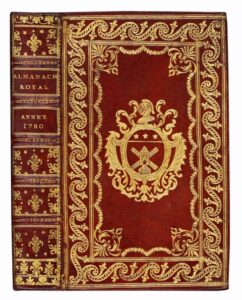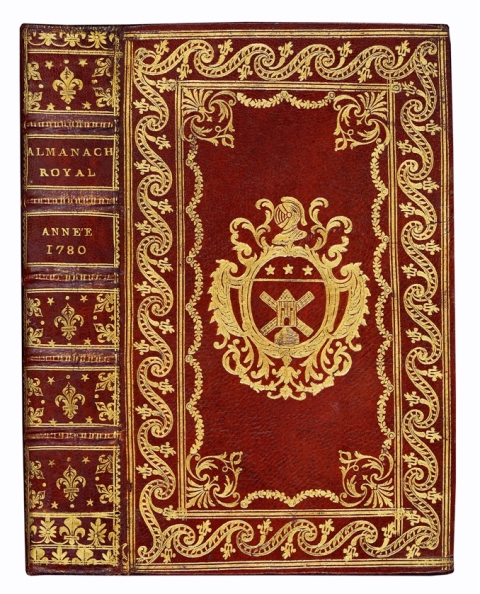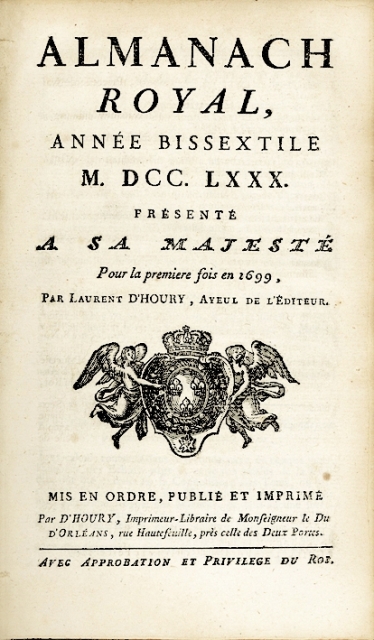8vo [192 x 118 mm] of 656 pp. Bound in full red morocco, covers decorated with gilt border and tools, gilt coat of arms at the center, spine ribbed and richly decorated with fleur-de-lis, inner border, blue watered silk doublures and endleaves, gilt edges. Decorated armorial binding made in 1780.
Magnificent copy of the 1780 royal Almanac presenting France, its regions and especially Provence with the dioceses of Marseille (p. 63), Arles and Aix, Sisteron, Valence (p. 64), Grasse, Vence, Abbeys of le Thoronet (p. 76), Mazan, St-Gilles, Senanque, Abbeys of daughters of Beaucain (p. 87), Hieres (p. 89), Soyons, etc. The Academy of Arts in Marseille etc., general remarks about Provence (p. 569), the cities of Aix and Marseille with the name of the factories Inspectors of these cities, fairs of Provence (p. 602), the roads and stagecoaches of Valence, Orange, Avignon, Aix and Marseille (p. 637) etc.
“Louis XIV, of glorious memory, having wished this almanac, asked it to the author, who had the honor to present it to His Majesty since 1699; this is what convinced him to give it under the title of Royal Almanac, and to make of this job his main occupation” M. Ch. d’Houry having outlived his father by only a year, his name disappeared the following year. From 1727 to 1745 the Almanac had only one printer’s name, the one of Houry’s widow. From 1746 it was jointly published by the widow, and by Le Breton, Houry’s grand-son. But when Houry’s widow herself died, in 1750, Le Breton remained single editor until 1779, the year of his death. During seven years, from 1780 to 1786, the direction of the Almanac was handled by Laurent Charles d’Houry, another grand-son of Laurent. When he died, in 1786, it was his son-in-law, François-Jean-Noël de Bure, who inherited the succession, but not for long, as in 1791 the Almanac is again signed by one of Houry’s widow, Laurent-Charles’ one. The primitive text of the year 1700 received several additions during the century, the number of matters having constantly increased. Gradually, indeed, from a kind of calendar that it was initially, with only a “general speech about the changes of air and other events of the year” and some pretty banal political predictions, the Almanac became a real official annual, no longer caring about “speeches” and “predictions”. In 1705 it gives the list of the knights of the St-Esprit, of the peers and marshals of France; in 1712, it announces the birth of sovereigns, princes and princesses of Europe; in 1716, it publishes the list of members composing the council of the house of Orléans, then, later (1723) the house of the King and in 1726 the house of the Queen and princes.
Take this Almanac of 1780, you will find there, in addition to information about the Provinces and especially Provence, hospitals, the Hospital des Petites Maisons with its fun nomenclature (it encloses, the note says, four objects “the first, these are the four hundred old people who are received there; the second, the foolish; the third, the ones sick with the venereal disease that are cured; the fourth, those afflicted with ringworm that are cured there”.); – the Tontines from the one of 1689 with all her heiresses, 1696, 1709, 1733, 1734, the two of 1743, 1744 ; – the complete list of the King’s secretaries since 1702; – the bankers “for the bills and allowances from place to place” (we must observe that many already are Swiss of Dutch); – the Royal Censors, important people and many are appointed for theology, case law, natural history, medicine and chemistry, surgery, mathematics, arts and history, geography, sailing and travels, engravings, and reach the number of 105; – the Academies of the King for the education of gentlemen; – the jurors created by decree in 1690; – the libraries; – the Doctors of the Faculty of Paris, of the King (many are from the Faculty of Montpellier), of the Queen, of M. the Dauphin, of Mme the Dauphine, of the Great Court Council, of the Parliament, the Doctors and surgeons of the King at the Châtelet, the Doctors and Surgeons of the King in each province (military); the Surgeons, Masters in the art and science of surgery of Paris, since 1696, the Apothecaries since 1703.
Superb copy preserved in its contemporary armorial binding.
Provenance: ex libris Santa Marina.



